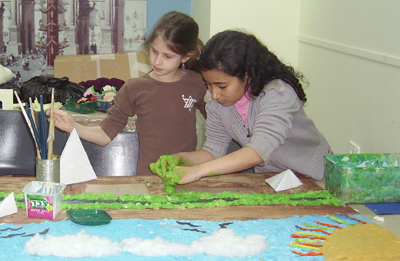
(RNS1-APR21) Jewish and Arab children from Jerusalem create scenes from the life of the patriarch Abraham, their common ancestor, during a co-existence project at the Bible Lands Museum. For use with RNS-JEWS-ARABS, transmitted April 21, 2010. RNS photo by Michele Chabin.
JERUSALEM (RNS) The smell of fresh paint and the sounds of kids having a good time are a frequent occurrence at the Bible Lands Museum, where hundreds of local Jewish and Arab children take part each year in the Image of Abraham co-existence project.
During a recent meeting of fourth-graders from the Hayovel School in predominantly Jewish West Jerusalem, and the Aum Toba School in mostly Arab East Jerusalem, the children worked together.
Standing side-by-side, they put the finishing touches on their collective art projects: large diorama-type renderings of Egypt and Caanan in the time of the patriarch Abraham, the father of Isaac and Ishmael.
One mixed group of Jewish and Arab kids — indistinguishable but for the languages they spoke — placed mosaic-covered pyramids on piles of glued sand; in Canaan, the Promised Land, the children erected both a mosque and synagogue that stand side-by-side in perfect harmony.
It’s the kind of peaceful coexistence envisioned by grownups, especially during times of heightened political tension or violence — including recent Israeli-Palestinian sparring over the fate of East Jerusalem.
While Jewish and Arab adults tend to turn away from each other during difficult times, people engaged in co-existence projects say they make a conscious effort to fight that urge — especially when it comes to children.
“We have only one option: to live by our values and to relate to one another’s humanity,” said Forsan Hussein, the Arab-Israeli CEO of the Jerusalem International YMCA, whose facility in mostly Jewish West Jerusalem houses the award-winning interfaith Peace Preschool.
At the Bible Lands Museum, watching the pint-sized Jewish-Arab interaction with satisfaction, program director Ragheda Kashkoosh conceded she had doubted whether the meeting would ever take place.
Like other local co-existence programs, Kashkoosh said, the Image of Abraham “could not help but be affected” by the Arab-Jewish violence that erupted in March and has simmered ever since.
“I hoped it wouldn’t be a repeat of last year, when the Arab parents pulled their kids out during the war in Gaza,” Kashkoosh, an Arab, said. “The parents felt there was too much anger for dialogue.”
The violence — the worst to hit Jerusalem in years — began after Israel said it would build a Jewish housing complex in East Jerusalem, an area that Palestinians claim for their future capital.
Fighting intensified just before Israel rededicated an East Jerusalem synagogue destroyed by Jordanian troops in 1948; Israel captured East Jerusalem, from Jordan during the 1967 Middle East war.
Naamati Alayon, a fourth-grade teacher at the Aum Toba School, said she considered canceling the meeting because of stones and rubber bullets being fired not far from her school.
“When the violence erupted we talked about whether or not to come to the museum. Some of the children worried that the Jewish students might be mad at them or afraid of them. Some thought the Israeli kids might hit them. They said, `We have really nice Jewish friends. Why is this violence happening outside?”‘
Dafna Ben-Ami, the Jewish kids’ homeroom teacher, said she had a similar conversation with her students.
“We talked about politics, about the situation, but the kids had no hesitations about coming to the museum,” Ben-Ami said. “They were eager to see their friends.”
Adena Levine, director of the Peace Preschool housed at the Jerusalem International YMCA, acknowledges that keeping political turmoil away from the classroom isn’t easy.
“We don’t live in a vacuum,” said Levine, who is Jewish. “Our teachers sometimes arrive sad because of what’s happening outside, but we leave it at the door.”
Sometimes, though, it’s impossible to keep the door bolted.
“Terror doesn’t discriminate between Jews and Arabs,” Levine said, recalling a 2008 terror attack just down the street from the International YMCA. “It was a terrible time. I heard shooting and ambulances. We rushed the children inside and into rooms facing away from the street. It was terrifying.”
But because violence doesn’t discriminate, neither does sympathy.
During the Second Lebanon War in 2006, the preschool’s Arab teacher called Levine to see whether Levine’s husband, a civilian called up by the army reserves, was safe. “It was a beautiful thing,” she recalled.
This caring extends to the children and parents, who mingle together at the Y’s playground on “Family Fridays.”
“The kids don’t know the word `Arab’ or `Jew.’ All they know is that they have friends with a different language,” Levine said. “We’re an island of sanity in an insane country.”
Ma’ayan Reiter, a petite 9-year-old Jewish girl from the Hayovel School, feels the same way about the Image of Abraham program.
“Sure, there are tensions between Jews and Arabs, but they care about the things we care about. What you see in the news doesn’t say anything about the kids I’ve met here,” Reiter said, looking toward the Arab children in her museum group.
“At first I didn’t want to come today,” admitted 10-year-old Amjad Abu-Tier from the Aum Toba School, “but I decided to because I like it here. We work together,” he said.
He put his arm around a Jewish boy he recently befriended. “And the others need me.”




